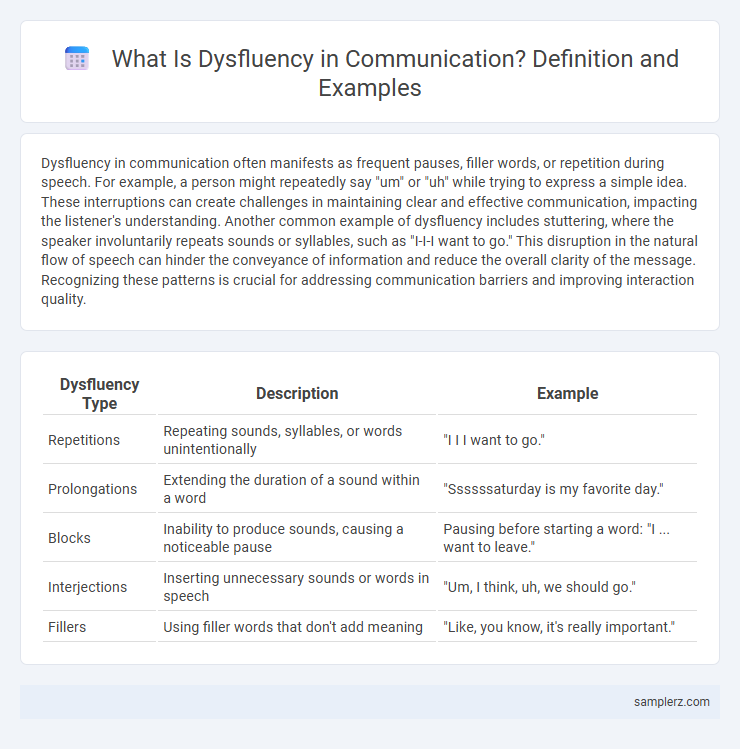Dysfluency in communication often manifests as frequent pauses, filler words, or repetition during speech. For example, a person might repeatedly say "um" or "uh" while trying to express a simple idea. These interruptions can create challenges in maintaining clear and effective communication, impacting the listener's understanding. Another common example of dysfluency includes stuttering, where the speaker involuntarily repeats sounds or syllables, such as "I-I-I want to go." This disruption in the natural flow of speech can hinder the conveyance of information and reduce the overall clarity of the message. Recognizing these patterns is crucial for addressing communication barriers and improving interaction quality.
Table of Comparison
| Dysfluency Type | Description | Example |
|---|---|---|
| Repetitions | Repeating sounds, syllables, or words unintentionally | "I I I want to go." |
| Prolongations | Extending the duration of a sound within a word | "Ssssssaturday is my favorite day." |
| Blocks | Inability to produce sounds, causing a noticeable pause | Pausing before starting a word: "I ... want to leave." |
| Interjections | Inserting unnecessary sounds or words in speech | "Um, I think, uh, we should go." |
| Fillers | Using filler words that don't add meaning | "Like, you know, it's really important." |
Understanding Dysfluency in Communication
Dysfluency in communication often manifests as frequent hesitations, repetitions, or filler words that disrupt the smooth flow of speech. Such interruptions can hinder message clarity and listener comprehension, especially in high-stakes environments like presentations or negotiations. Recognizing patterns of stuttering, self-corrections, or prolonged pauses helps diagnose underlying cognitive or emotional challenges affecting verbal communication effectiveness.
Common Types of Dysfluencies
Common types of dysfluencies in communication include repetitions, prolongations, and interjections. Repetitions involve repeating sounds, syllables, or words, such as stuttering on initial consonants. Prolongations occur when a sound is extended longer than typical, while interjections insert unnecessary words or sounds like "uh" or "um," disrupting the natural flow of speech.
Fillers: “Um,” “Uh,” and Their Impact
Fillers such as "um" and "uh" are common examples of dysfluency in communication that can disrupt the flow of speech and decrease listener comprehension. Frequent use of these fillers signals hesitation, uncertainty, or cognitive processing, which may undermine a speaker's credibility and clarity. Reducing filler usage enhances speech fluency, promoting more effective and confident communication.
Repetitions and Their Role in Speech
Repetitions in speech, such as repeating sounds, syllables, or words, are common examples of dysfluency that can disrupt communication clarity and flow. These occurrences often signal hesitation or difficulty in word retrieval, impacting the speaker's ability to convey messages smoothly. Understanding the role of repetitions helps in diagnosing speech disorders like stuttering and improving therapeutic interventions.
Pauses and Hesitations in Verbal Exchange
Pauses and hesitations are common examples of dysfluency in communication, often occurring when a speaker searches for the right word or organizes thoughts. These interruptions can affect the flow and clarity of verbal exchanges, sometimes signaling uncertainty or cognitive processing. Recognizing and managing these dysfluencies can enhance communication effectiveness and listener comprehension.
False Starts and Corrections in Conversation
False starts occur when a speaker initiates an utterance but interrupts themselves to restart or rephrase, revealing hesitation or uncertainty. Corrections follow false starts as speakers adjust their statements to clarify meaning, enhance accuracy, or repair misunderstandings during real-time conversations. These dysfluencies impact conversational flow but serve as natural mechanisms to improve communication clarity and listener comprehension.
Prolongations: Stretching Sounds in Speech
Prolongations in speech refer to the extended duration of specific sounds, which disrupt the natural flow of communication and can hinder message clarity. Common examples include the excessive stretching of consonants or vowels, such as lengthening the "s" in "ssssun" or the "m" in "mmmom." These dysfluencies often cause listeners to experience difficulty processing spoken information, impacting effective communication and social interaction.
Interjections: Frequent Interruptions in Dialogue
Interjections such as "um," "uh," and "like" serve as common examples of dysfluency that cause frequent interruptions in dialogue, disrupting the natural flow of communication. These fillers often signal hesitation or uncertainty, affecting listener comprehension and engagement. Addressing interjection-driven dysfluencies improves clarity and promotes more effective verbal exchanges in both casual and professional conversations.
Stuttering as a Dysfluency Example
Stuttering is a common example of dysfluency characterized by involuntary repetitions, prolongations, or blocks in speech that disrupt the normal flow of communication. This speech disorder affects approximately 1% of the global population and often emerges in early childhood, impacting verbal expression and social interactions. Effective interventions such as speech therapy can significantly improve fluency and communication confidence for individuals who stutter.
Strategies to Reduce Dysfluency in Communication
Strategies to reduce dysfluency in communication include practicing deliberate speech pacing and engaging in mindfulness techniques to enhance focus during conversations. Utilizing speech therapy exercises, such as controlled breathing and fluency shaping, can effectively minimize stuttering and pauses. Incorporating feedback from communication partners and recording speaking sessions helps identify patterns and track progress toward smoother speech.

example of dysfluency in communication Infographic
 samplerz.com
samplerz.com